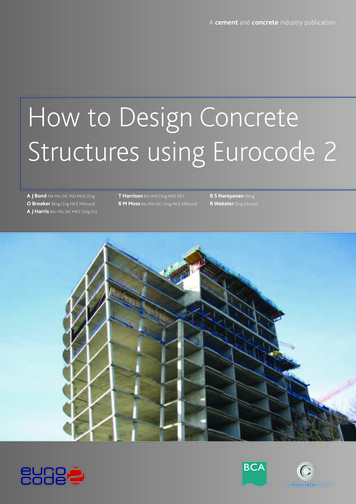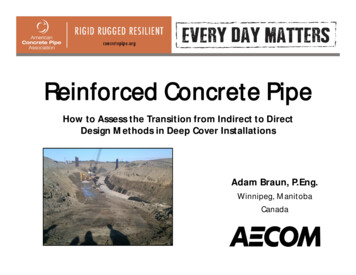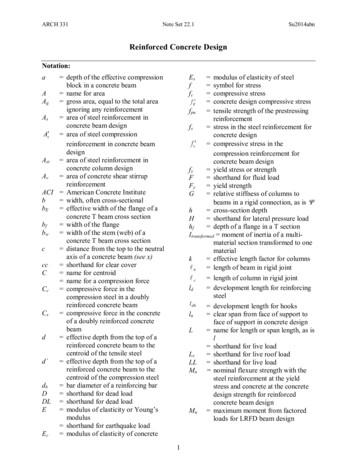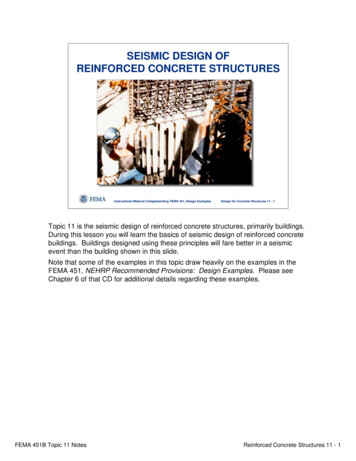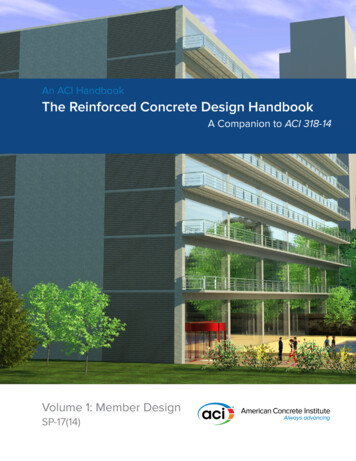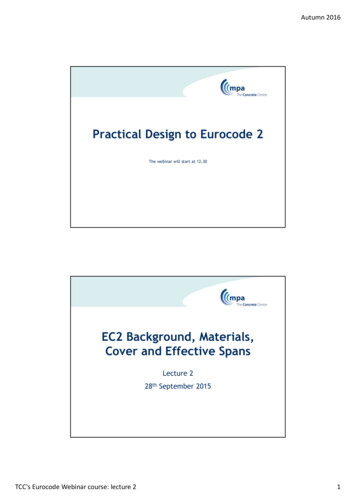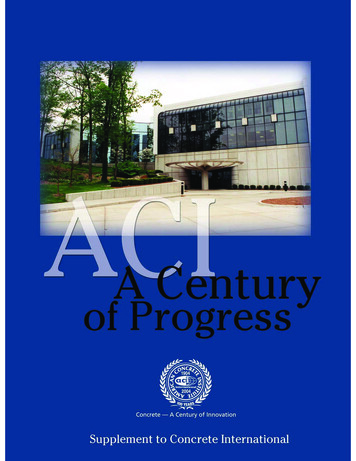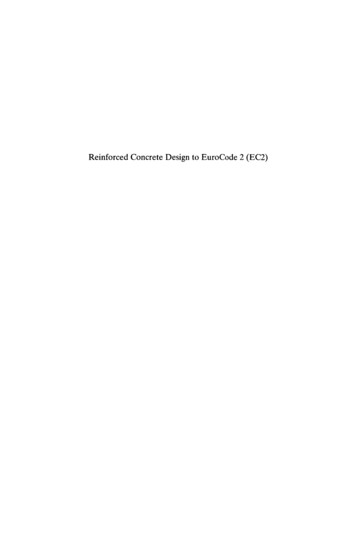
Transcription
Reinforced Concrete Design to EuroCode 2 (EC2)
Other titles of interest to civil engineersCivil Engineering Contract Administration and Control, 2nd editionI. H. SeeleyCivil Engineering Materials, 4th editionN. Jackson and R. Dhir (Editors)Fundamental Structural AnalysisW. J. SpencerReinforced Concrete Design, 4th editionW. H. Mosley and J. H. BungeySoil Mechanics- Principles and PracticeG. BarnesStructural MechanicsJ. Cain and R. HulseSurveying for Engineers, 3rd editionJ. Uren and W. F. PriceUnderstanding HydraulicsL. HamillUnderstanding StructuresDerek Seward
REINFORCED CONCRETEDESIGN TO EUROCODE 2(EC2)W. H. MosleyNanyang Technological University, SingaporeR. HulseCoventry UniversityandJ. H. BungeyUniversity of Liverpool
W. H. Mosley, R. Hulse and J. H. Bungey 1996All rights reserved. No reproduction, copy or transmissionof this publication may be made without written permission.No paragraph of this publication may be reproduced, copiedor transmitted save with written permission or in accordancewith the provisions of the Copyright, Designs and Patents Act1988, or under the terms of any licence permitting limitedcopying issued by the Copyright Licensing Agency,90 Tottenham Court Road, London W1P 9HE.Any person who does any unauthorised act in relation tothis publication may be liable to criminal prosecution andcivil claims for damages.First published 1996 byMACMILLAN PRESS LTDHoundmills, Basingstoke, Hampshire RG21 6XSand LondonCompanies and representativesthroughout the worldISBN 978-0-333-60878-4DOl 10.1007/978-1-349-13413-7ISBN 978-1-349-13413-7 ( eBook)A catalogue record for this book is availablefrom the British Library
ContentsPrefaceviiiNotationxi1Properties of Reinforced Concrete1.11.21.31.41.51.62Limit State Design2.12.22.32.434Composite ActionStress-Strain RelationsShrinkage and Thermal MovementCreepDurabilitySpecification of MaterialsLimit StatesCharacteristic Material Strengths and CharacteristicLoadsPartial Factors of SafetyGlobal Factor of SafetyAnalysis of the Structure3.13.23.33.4LoadsLoad Combinations and PatternsAnalysis of Beams and FramesRedistribution of Moments113813141518192021242930313356Analysis of the Section624.14.24.34.44.563Stress-Strain RelationsDistribution of Strains and Stresses across a SectionBending and the Equivalent Rectangular Stress BlockSingly Reinforced Rectangular Section in BendingRectangular Section with CompressionReinforcement at the Ultimate Limit Statev65676873
CONTENTSvi4.64.74.84.94.10Flanged Section in Bending at the Ultimate LimitStateMoment Redistribution and the Design EquationsBending Plus Axial Load at the Ultimate Limit StateRectangular- Parabolic Stress BlockTriangular Stress Block8087921031065Shear, Bond and TorsionShear5.15.2Anchorage BondLaps in Reinforcement5.3Analysis of Section Subject to Torsional Moments5.41136Serviceability, Durability and Stability RequirementsDetailing Requirements6.1Span-Effective Depth Ratios6.2Calculation of Deflection6.3Flexural Cracking6.4Thermal and Shrinkage Cracking6.56.6Other Serviceability RequirementsLimitation of Damage caused by Accidental Loads6.713978Design of Reinforced Concrete BeamsPreliminary Analysis and Member SizingDesign for BendingDesign for ShearBar SpacingContinuous BeamsCantilever BeamsDesign for .37.47.57.67.7187190207214214221222Design of Reinforced Concrete Slabs8.1Shear in SlabsSpan-Effective Depth Ratios8.2Reinforcement Details8.3Solid Slabs Spanning in One Direction8.4Solid Slabs Spanning in Two Directions8.58.6Flat Slab Floors8.7Ribbed and Hollow Block Floors8.8Stair Slabs8.9Yield Line and Strip Methods227228233233234242248257261266
CONTENTS9Column Design9.1Loading and Moments9.2Column Classification and Failure Modes9.3Reinforcement Details9.4Short Columns Resisting Moments and Axial Forces9.5Non-Rectangular Sections9.6Biaxial Bending of Short Columns9. 7Design of Slender Columns9.8Wallsvii27627627928328529730130430910 Foundations and Retaining Walls10.1Pad Footings10.2Combined Footings10.3Strap Footings10.4Strip Footings10.5Raft Foundations10.6Piled Foundations10.7Retaining restressed Concrete11.1Principles of Prestressing11.2Methods of Prestressing11.3Analysis of Concrete Section under Working Loads11.4Design for the Serviceability Limit State11.5Analysis and Design at the Ultimate Limit StateAppendix407Further Reading421Index423
PrefaceThe purpose of this book is to provide a straightforward introduction tothe principles and methods of design for concrete structures. It is directedprimarily at students and young engineers who require an understandingof the basic theory and a concise guide to design procedures. Althoughthe detailed design methods are generally according to EuropeanStandards (EuroCodes), much of the theory and practice is of a fundamental nature and should, therefore, also be useful to engineers incountries outside Europe.The search for harmonisation of Technical Standards across theEuropean Community (EC) has led to the development of a series ofthese Structural EuroCodes which are the technical documents intendedfor adoption throughout all the member states. The use of these commonstandards is intended to lower trade barriers and enable companies tocompete on a more equitable basis throughout the EC. EuroCode 2(EC2) deals with the design of concrete structures, which has most recentlybeen covered in the UK by British Standard BS8110 which supersededBritish Standard CPllO in 1985. Limit state principles established bythese British Standards are also adopted by EuroCode 2.The code drafting committee has also produced a range of supportingdocuments giving commentary and background explanation for some ofthe requirements of the code. Further supporting documentation includes,for each separate country, the National Application Document (NAD)which includes information specific to the individual member states.Additionally the British Cement Association has produced The ConciseEuroCode for the Design of Concrete Buildings which contains materialthat has been distilled from EC2 but is presented in a way that makes itmore user-friendly than the main EuroCode and contains only thatinformation which is essential for the design of more everyday concretestructures. It also contains information not included in EC2 such asdesign charts and design methods drawn from previous British Standardsviii
PREFACEixsuch as BS8110 and CPllO. In this text, reference is made to both EC2and the Concise Code.The presentation of EC2 is quite different from that of BS8110.However the essential feature of EC2 is that the principles of designembodied in the document are almost identical to the principles inherentin the use of BS8110. Hence, although there are some differences indetail, engineers who are used to designing to the existing British Standardshould have no difficulty in grasping the essential features of this newcode.Changes in terminology, arising partly from language differences, haveresulted in the introduction of a few terms which are unfamiliar toengineers who have worked with BS8110. The most obvious of these isthe use of actions to describe the loading on structures and the use of theterms permanent and variable actions to describe dead and imposed loads.Notwithstanding this, UK influence in drafting the document has beenvery strong and terminology is broadly the same as in existing BritishStandards. Throughout this text, terminology has been kept as consistentlyas possible in line with common accepted UK practice and hence, forexample, loads has been used instead of actions in subsequent chapters.Other 'new' terminology will be identified at appropriate points in thetext.The subject matter in this book has been arranged so that chapters 1 to5 deal mostly with theory and analysis while the subsequent chapterscover the design and detailing of various types of member and structure.In order to include topics that are usually in an undergraduate course,there is a section on earth-retaining structures and also a final chapter onprestressed concrete.Important equations that have been derived within the text are highlighted by an asterisk adjacent to the equation number and in the Appendix a summary of key equations is given. Where it has been necessaryto include material which is not directly provided by the EuroCodes, thishas been based on currently accepted UK good practice.In preparing this book, the principal aim has been to retain the structure and features of the well established book Reinforced Concrete Designby Mosley and Bungey (Macmillan Press, 1990) which is based on BritishStandards and is currently in its 4th edition. By comparing both books itis possible to compare the essential differences between EuroCode 2 andexisting British Standards and to contrast the different outcomes whenstructures are designed to either codes.It should be emphasised that Codes of Practice are always liable to berevised and readers should ensure that they are using the latest edition ofany relevant standard.Extracts from European Standards are reproduced by permission ofthe British Standards Institution, Linford Wood, Milton Keynes, Bucks.,
XPREFACEfrom whom complete copies can be obtained. Extracts from the ConciseEuroCode for the Design of Concrete Structures are reproduced by permission of the British Cement Association, Century House, TelfordAvenue, Crowthorne, Berks., from whom copies of the Concise EuroCodecan be obtained.Finally, the authors would like to thank Mr J. Birch for his assistancewith the preparation of parts of the text and Mrs Jamillah Sa'adon fortyping part of the manuscript.
NotationNotation is generally in accordance with EC2 and the principal symbolsare listed below. Other symbols are defined in the text where necessary.The symbols e for strain and f for stress have been adopted throughout,with the general system of subscripts such that the first subscript refers tothe material, c- concrete, s- steel, and the second subscript refers to thetype of stress, c- compression, t- tension.EFGIKMNQTVabdd'ehkln1/rsmodulus of elasticityload (action)permanent loadsecond moment of areaprestress loss factormoment or bending momentaxialloadvariable loadtorsional momentshear forcedeflectionbreadth or widtheffective depth of tension reinforcementdepth to compression reinforcementeccentricityoverall depth of section in plane of bendingradius of gyrationcoefficientlength or spanultimate load per unit areacurvature of a beamspacing of shear reinforcement or depth of stress blockxi
bwfckfernfctm[pk/ykgkkiNOTATIONthicknesspunching shear perimeterneutral axis depthlever armconcrete cross-sectional areacross-sectional area of prestressing tendonscross-sectional area of tension reinforcementcross-sectional area of compression reinforcementcross-sectional area of tension reinforcement required at theultimate limit statecross-sectional area of tension reinforcement provided at theultimate limit statecross-sectional area of shear reinforcement in the form of links orbent-up barssecant modulus of elasticity of concretemodulus of elasticity of reinforcing or prestressing steelcharacteristic permanent loadsecond moment of area of concretemoment on a column corresponding to the balanced conditiondesign value of momentultimate moment of resistanceaxial load on a column corresponding to the balanced conditiondesign value of axial forceinitial prestress forcecharacteristic variable loaddesign value of torsional momentdesign value of shear forcecharacteristic wind loadminimum width of sectioncharacteristic cylinder strength of concretemean cylinder strength of concretemean tensile strength of concretecharacteristic yield strength of prestressing steelcharacteristic yield strength of reinforcementcharacteristic permanent load per unit areaaverage compressive stress in the concrete for a rectangularparabolic stress blocka factor that relates the depth to the centroid of the rectangularparabolic stress block and the depth to the neutral axislever-arm factor zldeffective height of column or wallcharacteristic variable load per unit area
NOTATIONYcYtYGYoYs6eacppartial safety factor for concrete strengthpartial safety factor for loads (actions), Fpartial safety factor for permanent loads, Gpartial safety factor for variable loads, Qpartial safety factor for steel strengthmoment redistribution factorstrainstressbar diameterxiii
In preparing this book, the principal aim has been to retain the struc ture and features of the well established book Reinforced Concrete Design by Mosley and Bungey (Macmillan Press, 1990) which is based on British Standards and is
